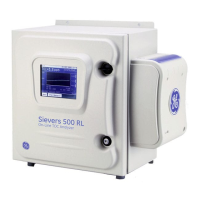GE Analytical Instruments ©2010 63 of 226 DLM 74001-04 Rev. A
Chapter 3: Installation
prompts you to archive data to free up memory; when Archive Data is set to Off, the Analyzer will make space
for new data in memory by overwriting the oldest data. The data history can accommodate approximately
33,000 entries (at least 90 days of usage).
1. Select the Data tab.
2. Press the Setup History button.
3. Set Archive Data to On.
4. Press the Menu button.
Setting Up the Printer (Optional)
If you installed a printer in “Installing the Printer” on page 54, configure the printer port to match the printer.
1. Select the I/O tab and press the Printer button.
2. Press the Printer button and select your printer model, either Citizen, Seiko, or Epson. If you do not
have a printer, make sure No Printer is selected.
3. Press the Header Freq. button and select First Page to print a header only on the first page of output
or select All Pages to print a header on all pages of output.
4. Press the Print Freq. button and select how often you would like to print TOC data information.
Exporting and Printing System Settings
Calibration constants and other key parameters are stored in the Analyzer’s memory. You should export and
print the factory settings for future reference.
To export the system to a configured file and an encrypted file for DataShare 500 software, follow these steps:
1. Select the Maintenance tab.
2. Press the Advanced button.
3. Press the USB I/O button. Make sure that the USB flash memory drive from the Analyzer’s accessory kit
is attached to the USB port, then press the Save System button. Archive the exported files in a secure
location on your computer.
4. Press the Back button and then press the Menu button.
If you have a printer attached to the Analyzer, you can print these settings for future reference by following these
steps:
Note:
If DataGuard is enabled, data must either be sent to storage or the serial port. See
“Using DataGuard” on page 105 for more information.

